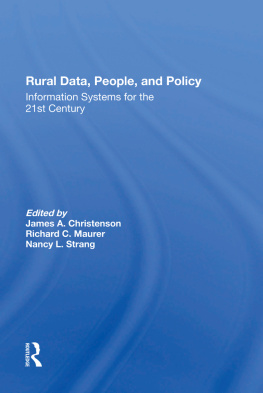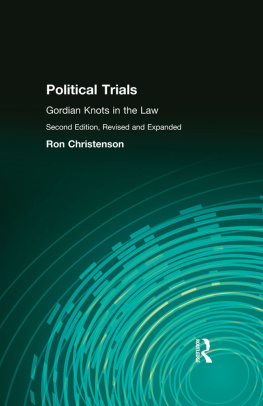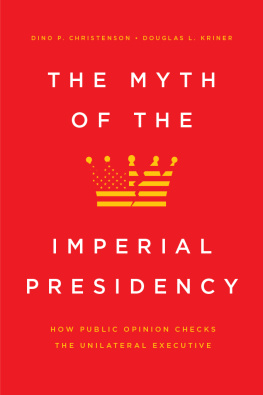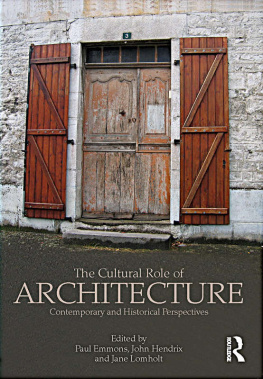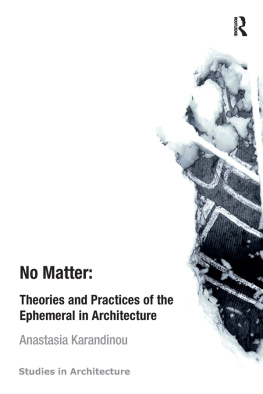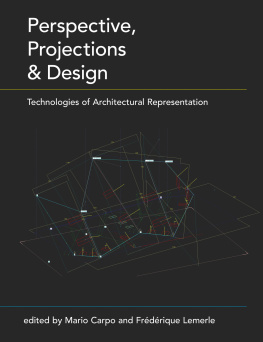Christenson - Theories and practices of architectural representation
Here you can read online Christenson - Theories and practices of architectural representation full text of the book (entire story) in english for free. Download pdf and epub, get meaning, cover and reviews about this ebook. year: 2019, publisher: Routledge, genre: Romance novel. Description of the work, (preface) as well as reviews are available. Best literature library LitArk.com created for fans of good reading and offers a wide selection of genres:
Romance novel
Science fiction
Adventure
Detective
Science
History
Home and family
Prose
Art
Politics
Computer
Non-fiction
Religion
Business
Children
Humor
Choose a favorite category and find really read worthwhile books. Enjoy immersion in the world of imagination, feel the emotions of the characters or learn something new for yourself, make an fascinating discovery.
- Book:Theories and practices of architectural representation
- Author:
- Publisher:Routledge
- Genre:
- Year:2019
- Rating:3 / 5
- Favourites:Add to favourites
- Your mark:
- 60
- 1
- 2
- 3
- 4
- 5
Theories and practices of architectural representation: summary, description and annotation
We offer to read an annotation, description, summary or preface (depends on what the author of the book "Theories and practices of architectural representation" wrote himself). If you haven't found the necessary information about the book — write in the comments, we will try to find it.
Christenson: author's other books
Who wrote Theories and practices of architectural representation? Find out the surname, the name of the author of the book and a list of all author's works by series.
Theories and practices of architectural representation — read online for free the complete book (whole text) full work
Below is the text of the book, divided by pages. System saving the place of the last page read, allows you to conveniently read the book "Theories and practices of architectural representation" online for free, without having to search again every time where you left off. Put a bookmark, and you can go to the page where you finished reading at any time.
Font size:
Interval:
Bookmark:

Theories and Practices of Architectural Representation focuses on the study of architectural knowledge approached through the lens of representation: the making of things-about-buildings. Architectural knowledge systems continue to shift away from traditional means, such as books and photographs, into modes dominated by digital technologies. This shift parallels earlier ones developed by craftspeople into the knowledge of painters and writers, or shifts from manually produced knowledge into the mode of photography and film. These historical shifts caused profound disruptions to established patterns, and in general the shift currently underway is no different.
This book considers essential questions including: How does architecture become known? How is knowledge about architecture produced, structured, disseminated, and consumed? How in particular do historical patterns of knowledge production persist within contemporary culture and society? How are these patterns affected by changes in technology, and how does technology create new opportunities? These questions are examined through five chapters dealing with exemplary buildings and representational methods selected from worldwide locations including the United States, Japan, and Italy.
Theories and Practices of Architectural Representation proposes that historical theories and practices of architectural representation remain distinct, robust, and uniquely viable within the context of rapidly changing technologies. It is an essential read for students of architectural theory of representation.
Mike Christenson, AIA, Professor of Architecture at the University of Minnesota, is the author of the book Beginning Design Technology (Routledge, 2016), a member of the Board of Directors of the Association for Computer-Aided Design in Architecture, and Associate Editor for Architectural Computing for the journal Architectural Science Review.
In Theories and Practices of Architectural Representation, Mike Christenson provides a well-written, thorough introduction to the many complex ways architectural representation and architecture are inextricably entwined and, in some ways, identical. With thoughtful discussions of numerous well-chosen examples, he reminds architects that representations are never transparent or neutral, that we must constantly ask ourselves what does representation obscure, what does it silence, and what does it omit?
David Ross Scheer, author ofThe Death of Drawing:Architecture in the Age of Simulation
In this scholarly palimpsest, Christenson embarks on an ambitious intellectual journey that redefines architectural representation not just as a multidimensional framework for design, but also as a variegated lens for approaching, experiencing, critiquing, and understanding architecture and the technological agencies of its making in the age of robotics and artificial intelligence. This compelling book is well-illustrated and rigorously grounded in a meshwork of scholarly sources drawn from several disciplines. Any reader interested in architecture as a cultural practice would find this delectable book captivating.
Mahesh Daas, DPACSA, author of Leading with Aesthetics: The Transformational Leadership of Charles M. Vest at MIT, and co-editor of Towards a Robotic Architecture
Theories and Practices of Architectural Representation presents an excellent foundation for understanding the basic principles of architectural thinking, as it pertains to the media and processes architects use to design buildings. It explores strategies for engaging the set of conceptual tools that architects employ in a clear, concise and accessible way. Identifying architectural representation as the artifacts of process, the book clearly explains concepts such as iteration, interface and deformation to address current and future technologies. Useful and engaging, the book provides examples to assess theories of architectural representation for practitioners and students of architecture alike.
Kendra Schank Smith, Ph.D., FRAIC Ryerson University

First published 2019
by Routledge
52 Vanderbilt Avenue, New York, NY 10017
and by Routledge
2 Park Square, Milton Park, Abingdon, Oxon, OX14 4RN
Routledge is an imprint of the Taylor & Francis Group, an informa business
2019 Taylor & Francis
The right of Mike Christenson to be identified as author of this work has been asserted by him in accordance with sections 77 and 78 of the Copyright, Designs and Patents Act 1988.
All rights reserved. No part of this book may be reprinted or reproduced or utilised in any form or by any electronic, mechanical, or other means, now known or hereafter invented, including photocopying and recording, or in any information storage or retrieval system, without permission in writing from the publishers.
Trademark notice: Product or corporate names may be trademarks or registered trademarks, and are used only for identification and explanation without intent to infringe.
Library of Congress Cataloging-in-Publication Data
Names: Christenson, Mike, author.
Title: Theories and practices of architectural representation / Michael Christenson.
Description: New York : Routledge, 2019. | Includes bibliographical references and index.
Identifiers: LCCN 2018056326 | ISBN 9781138055872 (hardback) | ISBN 9781138055889 (pbk.) | ISBN 9781315165660 (e-book)
Subjects: LCSH: Architectural designPhilosophy. | Communication in architectural design.
Classification: LCC NA2750 .C49 2019 | DDC 729dc23
LC record available at https://lccn.loc.gov/2018056326
ISBN: 978-1-138-05587-2 (hbk)
ISBN: 978-1-138-05588-9 (pbk)
ISBN: 978-1-351-67779-0 (ebk)
Typeset in Bembo
by Apex CoVantage, LLC
While re-reading this manuscript upon its completion, I was reminded of ideas and questions Ive considered and tested in one way or another for almost forty years. In retrospect, I can trace my awareness of architectural representations unique disciplinary potential to the moment in 1980 when the old Chicago & Northwestern Railway Depot in my hometown of Winona, Minnesota, was demolished, triggering a childhood fascination with photography, architectural drawing, and the mechanisms of historic preservation. My subsequent visits in company with my mother to the local historical societys archives only prompted me to learn more, and particularly to begin experimenting with the way buildingslong-demolished buildings, existing ones, imaginary onescould be made visible through drawings and photographs. By the age of 9 I had made up my mind to pursue architecture as a career and I started on a long trajectory in which architectural drawing and photography remained central to my interests. Fourteen years later, while I was in the process of completing my undergraduate education and developing my architectural research under the supervision of Andrzej Piotrowski (then and now a professor at the University of Minnesota), I rigorously began to test my ideas concerning iteration, existing buildings, photography, and the conceptual mechanisms of digital models and images through the venue of a funded undergraduate research project. In my 1997 M. Arch. thesis, I asserted that while the processes of
Font size:
Interval:
Bookmark:
Similar books «Theories and practices of architectural representation»
Look at similar books to Theories and practices of architectural representation. We have selected literature similar in name and meaning in the hope of providing readers with more options to find new, interesting, not yet read works.
Discussion, reviews of the book Theories and practices of architectural representation and just readers' own opinions. Leave your comments, write what you think about the work, its meaning or the main characters. Specify what exactly you liked and what you didn't like, and why you think so.


